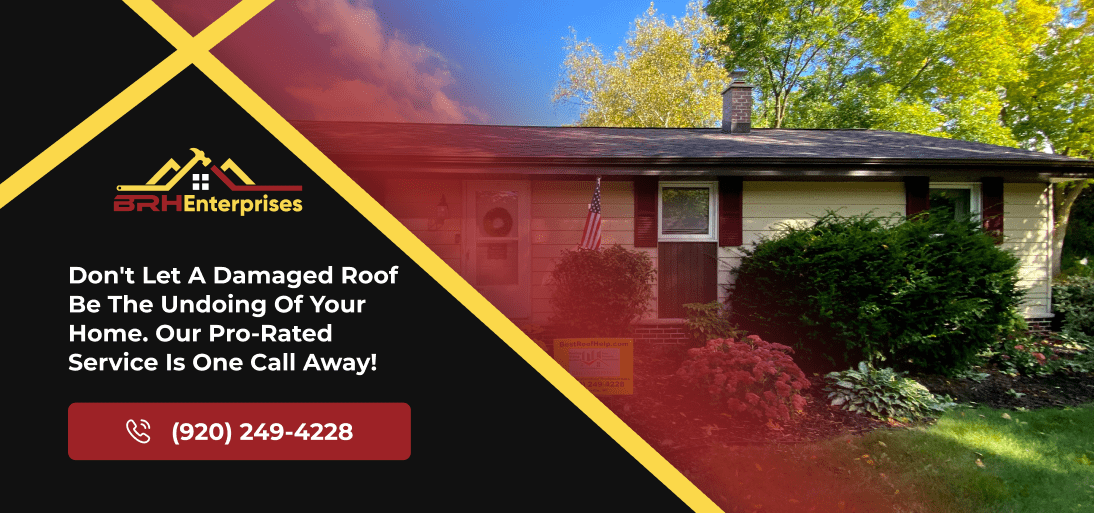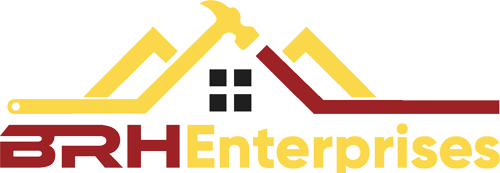Different Types Of Commercial Roof Insulation (And How To Choose The Right One In Wisconsin)
Estimated Reading Time : 7 Min.

When it comes to protecting your building and managing long-term energy costs, few decisions matter more than the insulation system beneath your commercial roof. The right insulation doesn’t just meet building codes, it helps your roof last longer, lowers your heating and cooling bills, and keeps your building comfortable year-round.
But the wrong choice can lead to ice dams, moisture buildup, and skyrocketing utility costs, especially in Wisconsin’s harsh freeze-thaw conditions, where moisture and heat loss go hand in hand.
At BRH Enterprises LLC, we’ve worked on commercial roofing systems across the state, and we’ve seen firsthand how proper insulation makes the difference between a durable, energy-efficient roof and one that fails before its time. In this guide, we’ll break down the different types of commercial roof insulation available today, how they perform, and how to choose the right one based on your building, budget, and climate zone.
*Please note: price ranges listed in this article may not reflect the final cost of your project. Prices are subject to change based on local labor rates, material quality, and more. All costs established in this article are rough estimates based on average industry rates.
What Are the Most Common Types of Commercial Roof Insulation?
What is the real difference between a roof that performs for decades and one that fails early? It often starts with what’s underneath the membrane. Below are the most widely used commercial insulation materials, along with how they hold up in Wisconsin’s climate.
1. Polyisocyanurate (Polyiso)
Polyiso is one of the most commonly used commercial roof insulation materials, and for good reason. It delivers one of the highest R-values per inch, between R5.5 and R8, of any rigid foam board insulation.
That makes it ideal for colder regions like Wisconsin, where space-saving insulation must meet performance standards and control heating costs. Polyiso boards are often used beneath single-ply membranes like TPO and EPDM, and they bond well with adhesives and fasteners. However, the material can lose R-value over time and may absorb moisture if not properly sealed, making installation quality a top priority.
2. Expanded Polystyrene (EPS)
EPS insulation is known for its affordability and versatility. Made from fused polystyrene beads, it offers a lower R-value of around R4 per inch but comes at a significantly lower cost than polyiso or XPS. EPS is often used in budget-conscious commercial projects and as part of SIPs (structural insulated panels). It resists mold and is easy to handle on the job site. However, it’s more permeable to moisture, so a vapor barrier may be needed in humid or freeze-thaw climates like Wisconsin. Its compressive strength is also lower than other rigid foams, making it less suitable for high-traffic or load-bearing sections of the roof.
3. Extruded Polystyrene (XPS)
XPS insulation is a step up from EPS in terms of moisture resistance and durability. With a consistent R-value of about R5 per inch, it performs reliably across a wide range of temperatures. XPS boards are commonly used in green roofs, plaza decks, or any application where exposure to water is a concern. In commercial retrofits, it’s often used as an overlay or within inverted roof systems. One drawback is that XPS is made using blowing agents with a higher global warming potential (GWP), which has raised some environmental concerns. That said, its performance under wet conditions makes it a top pick for Wisconsin’s snow and rain-heavy seasons.
4. Spray Polyurethane Foam (SPF)
SPF pulls double duty: insulating and waterproofing your roof in a single seamless layer. Applied as a liquid that expands into a rigid foam, it offers an R-value between R5.6 and R8 per inch, one of the highest for commercial roofing insulation. SPF conforms to any shape or substrate, creating a seamless, air- and water-tight barrier. It’s an especially good choice on complex or irregular roofs, retrofits, and buildings that need additional slope to improve drainage. However, SPF requires expert application. Poor installation can lead to curing issues or gaps, and the upfront cost is higher than that of board insulation. But for the right project, it’s one of the few systems that can pay off in both performance and lifespan.
5. Mineral Wool

Mineral wool insulation, made from molten rock or slag spun into fibers, is known for its fire resistance and acoustic properties. While its R-value is lower, at around R4, and isn’t as high as foam boards, it can withstand temperatures exceeding 1,800 degrees Fahrenheit and doesn’t absorb water or support mold growth. That makes it a great choice for industrial facilities, mechanical rooms, or commercial buildings requiring non-combustible materials. Its added weight and stiffness can complicate installation, but it brings major benefits in safety and sound control, two factors often overlooked in roof design.
BONUS: Tapered Insulation Systems
Tapered insulation isn’t a material so much as a system design. Typically made from polyiso or EPS, these systems gradually increase insulation thickness to create a slope on flat roofs, guiding water to drains and preventing ponding. Tapered insulation solves drainage issues while boosting thermal resistance, all without reworking your structural slope. While more expensive than flat-board installs, tapered systems are often a smart investment, mainly on large, flat commercial roofs in regions like Wisconsin where freeze-thaw cycles can accelerate ponding damage.
In the next section, we’ll break down R-values by material and explain what the Wisconsin code requires for commercial roofs.
What R-Value Does Your Commercial Roof Need in Wisconsin?
If you’re insulating a commercial roof in Wisconsin, you’re in Climate Zone 6 or 7. The International Energy Conservation Code (IECC 2021) calls for a minimum of R30 continuous insulation for low-slope commercial roof assemblies.
That means your insulation must deliver a total R-value of R30 or higher, without gaps or breaks that allow heat to escape.
Meeting code isn’t just about hitting a number, it’s also about how the insulation is installed. Even high-R-value materials can underperform if seams aren’t staggered or if thermal bridges (like fasteners or uninsulated gaps) are left unchecked. That’s why it’s always necessary to install multiple layers of board insulation with offset joints. It creates a tighter seal, improves long-term efficiency, and reduces heat loss through the roof deck.
Here’s how the most common commercial insulation materials compare:
| Material | R-Value (per inch) |
| Polyiso | R5.5 to R8 (avg. R5.5) |
| EPS | ~R4 |
| XPS | ~R5 |
| SPF | R5.6 to R8 |
| Mineral Wool | ~R4 |
It’s important to make sure your roof system isn’t just compliant but built to perform through every Wisconsin season.
How Do You Choose the Right Roof Insulation for Your Building?
No single insulation type works for every building. The right solution depends on your roof style, local climate, building use, and budget. First, consider whether you have a flat, low-slope, or metal roof. Flat roofs benefit from rigid board insulation like polyiso or from tapered systems that improve drainage. Metal roofs, on the other hand, often require blanket insulation, spray foam, or high-density boards to control thermal bridging and condensation.
Moisture is another key factor in Wisconsin, where snow, freeze-thaw cycles, and ice dams can wreak havoc on poorly insulated or improperly sealed roofs. In those cases, water-resistant materials like XPS or closed-cell spray foam can offer added protection.
Cost also plays a role. For budget-sensitive projects like warehouses or utility buildings, EPS or mineral wool can deliver reliable performance without breaking the bank. High-performance buildings or those seeking LEED or Energy Star certifications may opt for SPF or hybrid systems that combine insulation types to meet energy goals.
If you’re not sure what makes sense for your building, our team at BRH Enterprises LLC can inspect your current roof system and walk you through the most cost-effective, code-compliant options available.
What Will Commercial Roof Insulation Cost You in Wisconsin?
The cost of home insulation depends on the material you choose, the size and shape of your roof, and how complex the installation is. Whether you’re doing a full roof replacement, a retrofit, or just upgrading the insulation layer, understanding the material costs per square foot is a good starting point.
Here’s a general breakdown of insulation materials at 1-inch thickness:
| Material | Approx. Cost (Per Square Foot) | Notes |
| Polyiso | $0.40 to $0.70 | High-performance, widely used on flat roofs |
| EPS | $0.25 to $0.35 | Affordable and lightweight |
| XPS | $0.40 to $0.50 | Durable and moisture-resistant |
| SPF (Spray Foam) | $0.90 to $1 (per board foot) | Spray-applied; includes labor and air barrier |
| Mineral Wool | $1.20 to $2.40 | Fireproof, commonly used in industrial settings |
In colder climates like Wisconsin, reaching R30 often requires 4 to 6 inches of insulation, which can double or triple material costs. And that’s before accounting for labor, fasteners, adhesives, or tapered system upgrades.
Additional Cost Factors to Consider:
- Labor and installation methods: Mechanical fastening, adhesives, or spray foam systems all affect the total cost.
- Tapered insulation: Increases cost but solves drainage issues.
- Long-term energy savings: Higher-efficiency systems like polyiso and SPF tend to pay off faster by lowering long-term utility costs.
- Code compliance: Meeting R30 may require combining materials or installing multiple layers.
Why Does Insulation Installation Matter So Much?
How your insulation is installed can make or break its performance. Even top-tier materials won’t live up to their potential if they’re installed using shortcuts or outdated methods.
For most commercial projects, professionals mechanically fasten rigid insulation boards to steel or concrete decks using screws and plates. It’s a proven, reliable method that holds up well in Wisconsin’s tough seasonal weather. In low-VOC projects or sensitive environments, they might opt for cold adhesive systems, which bond the insulation without introducing strong fumes or requiring high heat.
Spray foam insulation adheres directly to the roof deck, forming a seamless thermal and moisture barrier. This type of monolithic application removes the risk of gaps, but it requires experienced installers and precise environmental conditions.
Professionals also pay close attention to fine details like staggering seams between insulation layers, sealing edges properly, and minimizing thermal bridges. A sloppy install doesn’t just waste insulation, it cuts your roof’s life short and can lead to repairs no one budgeted for. That’s why it’s essential to follow strict best practices every time, so your insulation system performs exactly as it should.
Ready to Insulate Smarter in Wisconsin?
Choosing the right commercial roof insulation isn’t just about R-values, it’s about matching materials to your building’s climate, structure, and long-term goals. At BRH Enterprises LLC, we’ve helped property managers across Wisconsin get the most out of their insulation systems through expert installs and roof planning.
Book a commercial roof inspection or consult today. Our team will walk you through your options and help you meet both energy codes and budget targets with zero guesswork.


